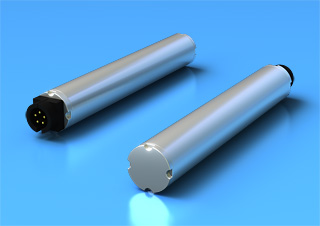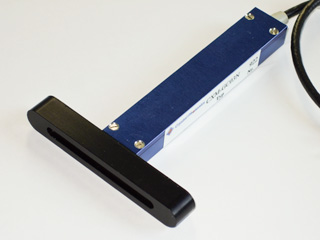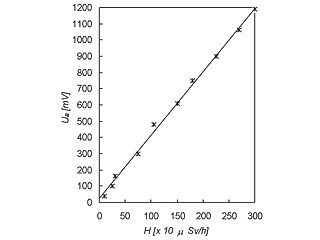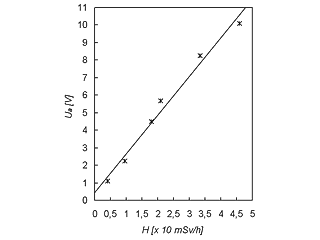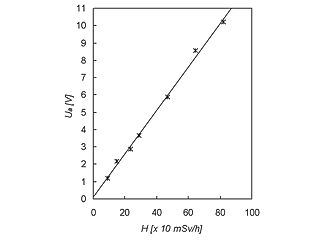Monitoring Detectors
1. Special Features
- output voltage is a linear function of dose rate
- high ß-, y- and x -ray sensitivity together with a wide dynamic range
- high stability and radiation hardness
- small size and rugged design
- amplifier electronics is integrated in detector package
- no high supply voltage needed
- insensitive against magnetic fields
- customer designed modification and special sensor-heads
- energy range:
- y- and x-rays: 5 keV - 2 MeV
- ß-rays: 25 keV - 5 MeV
- options for system adaption:
- sensitivity range tuning
- spectral selection of scintillation crystals
2. Intended use
The ß-, y- and x-ray detectors of our series CXM (Crystal x-ray monitor) has a great variety of applications in x-ray technology and the ß- and y-ray detection. Examples are the stochastic and continuous y-ray control, direct and indirect dose rate measurements, absorption measurements technology.
The detector types cover the whole energy range from 5 keV to about 2 MeV, but the detection of higher energies above 2 MeV is also possible. The design of construction offers the feasibility making linear-detectors of any length. Thus positioning-resolving measurements can be performed by computer aided analysis, as, for example, in signal processing systems.
The wide energy range of the detectors allows measurements of high energy y- and x-rays.
3. Design & Function
The ß-, y- and x-ray detector CXM consists of a scintillation crystal, readout by a Si-pin-photodiode and is mounted together with a preamplifier in an Al-package. A miniaturised switch for tuning the amplification can be fixed inside the detector packaging.
The length of scintillation crystal can be adapted to the detectable energy range. For ß- and soft x- and y-radiation (5 keV < E < 30 keV) we use the direct absorption in the Si-photodiode.
The entrance window is a new developed Be-free “low energy window”. Active areas between 2…200 mm2 are available. As option the preamplifier sensitivity and characteristics can be matched to the specific application. The detectors are available with screened four-wire cable or with miniaturised connector.
4. Examples
4.1. CXM-GC01 (CXM-S80)
For dose rate measurements of x-rays.
| Detector description | generally | monitor detector |
| specific | for low-energy gamma and x-ray radiation | |
| Radiation type | gamma and x-ray | |
| Energy range | keV | 15...60 |
| Sensor | pin-Photodiode | |
| Sensor size | mm² | 80 |
| Radiation entrance window | material, thickness | Alu, 0,3 mm |
| Cases | type | 1 |
| front radiation entrance | ||
| Size | LxWxH [mm³] | 70x18x10 |
| housing extension | no | |
| Connector | 5-wire cable or miniaturized plug | |
| Amplification tuning | no | |
| Typical application | dose rate measurement - x-ray |
4.2. CXM-S200
For intensity measurements of x-rays.
| Detector description | generally | monitor detector |
| specific | for low-energy gamma and x-ray radiation | |
| Radiation type | gamma and x-ray | |
| Energy range | keV | 15..60 |
| Sensor | pin-Photodiode | |
| Sensor size | mm² | 200 |
| Radiation entrance window | material, thickness | Ti-Foil, 25µm |
| Cases | type | 8 |
| side radiation entrance | ||
| Size | LxWxH [mm³] | 90x16x10 |
| housing extension | 40x16x4 | |
| Connector | 5-wire cable or miniaturized plug | |
| Amplification tuning | no | |
| Typical application | intensity measurement - x-ray |
4.3. CXM-S80/ß
For monitoring of beta radiation sources.
| Detector description | generally | monitor detector |
| specific | beta-detector | |
| Radiation type | beta radiation | |
| Energy range | keV | 100 ....2500 |
| Sensor | pin-Photodiode | |
| Sensor size | mm² | 80 |
| Radiation entrance window | material, thickness | Kapton; 8µm, 0,5µm AL |
| Cases | type | 6 |
| side radiation entrance | ||
| Size | LxWxH [mm³] | 90x16x10 |
| housing extension | 28x16x3 | |
| Connector | 5-wire cable or miniaturized plug | |
| Amplification tuning | no | |
| Typical application | monitoring: beta-source |
4.4. CXM-S80-U
For monitoring of PET-sources.
| Detector description | generally | monitor detector |
| specific | for high-energy gamma and x-ray radiation | |
| Radiation type | gamma radiation | |
| Energy range | keV | 80 ....1500 |
| Sensor | pin-photodiode mit scintillation crystal, 10 mm thick | |
| Sensor size | mm² | 80 |
| Radiation entrance window | material, thickness | Alu, 0,3 mm |
| Cases | type | 1a |
| front radiation entrance | ||
| Size | LxWxH [mm³] | 70x18x10 |
| housing extension | no | |
| Connector | 5-wire cable or miniaturized plug | |
| Amplification tuning | yes | |
| Typical application | monitoring: PET-source |
5. Technical Data
| absorption efficiency | depends on radiation energy and crystal specifications | |
| operating voltage | Ub = ± 15 V, Ub min = ± 4,5 V, Ub max = ± 18 V | |
| power consumption | P < 20 mW | |
| max. output voltage | Ua max ca. 13 V (RL >= 5 kOhm) | |
| max. output current | Ia max = 15 mA | |
| offset compensation | internal adjustment, default a few mV | |
| operating temperature | -20 °C ... +45 °C | |
| cable connector | 4-wire, shielded cable | |
| green: | Ua | |
| red: | Ub = + 15 V | |
| blue: | Ub = - 15 V | |
| yellow: | grounding | |
| shielding: | housing | |
Attention: With high sensitivity of the sensor (transimpedance 1010 and more) and at temperatures exceeding 35° C, the sensor may require a temperature stabilization!
6. Technical Specifications
6.1. Sensors without scintillation crystal (CXM-S...)
| active areas | round | 2, 5, 10, 50 mm2 |
| stripes | 20, 40 mm2 | |
| square | 80, 200, 400 mm2 | |
| housings | front entrance | active areas: 2, 5, 10, 50, 80 mm2 (variant 1) 1, 2; 20, 40 mm2 (variant 4) |
| side entrance (with housing extension) |
active areas: 50, 80 mm2 (variant 5) 6; 200 mm2 (variant 7, 8) | |
| electronic | preamplifier (standard transimpedance 108)
up to 5x1010 for higher sensitivities optional: 3 adjustable sensitivity ranges per miniaturized switch |
|
| connector | cable | grey, 4-wire, shielded, Ø = 3,1 mm |
| cable outlet | grey cables or miniaturized plugs | |
6.2. Sensors with scintillation crystal (CXM-Sz...)
| scintillator shape / -size | cylinder | d = 4 ... 9 mm, l = 1 ... 40 mm |
| cube | areas: 8x10 mm2, 10x20 mm2 length: 1 ... 20 mm |
|
| active areas | round | 2, 5, 10, 50 mm2 |
| square | 80, 200 mm2 | |
| housings | front entrance | active areas: 2, 5, 10, 50, 80 mm2 (variant 1, 2, 3) |
| side entrance (with housing extension) |
active areas: 50, 80, 200 mm2 (variante 5, 6, 7, 8) |
|
| electronic | preamplifier (standard transimpedance 108) up to 5x1010 for higher sensitivities optional: 3 adjustable sensitivity ranges per miniaturized switch |
|
| connector | cable | grey, 4-wire, shielded, Ø = 3,1 mm |
| cable outlet | grey cable or miniaturized plug, cables with wires | |
7. Dose Rate Measurement
Monitor detectors of the series CXM show a strictly linear dependence between the measured output voltage and the detected dose rate. For four typical cases:
- low radiation energy, small dose rate (Fig. 1)*
- low level of radiation energy, high dose rate(Fig. 2)*
- higher radiation energy, small dose rate (Fig. 3)*
- higher radiation energy, high dose rate (Fig. 4)*
the curves are shown in the pictures. The linear dependence is clearly verified.
7.1. Low Radiation Energy (8 keV)
CXM-S80 (active area 80mm2 ; no scintillation crystal). Conditions: X-ray source: FF Cu4; Cu-kα with kβ-Filter (measurements made with an internally calibrated dose rate meter)
7.2. High Radiation Energy (160 keV)
CXM-SZ50 (50 mm2, with scintillation crystal 40 mm). Conditions: X-ray source – MCD 160 (Fa. rtw); (measurements made with an internally calibrated dose rate meter)
7.3. Linearity comparison: CXM-Detector -- Geiger-Müller (GM) Counter
The extremely high dynamic range of the CXM-detectors of up to 105 is of advantage as also shown in comparison with alternative detector principles. Especially at higher activities, the CXM-detectors remain linear over a very large activity area, while Geiger-Müller counter tubes are already saturated and work highly non-linear. Fig. 5 shows a comparison of the CXM-detector and a Geiger-Müller counter tube under identical measurement conditions.**
All CXM-Sz… and CXD-Sz... – detectors are excellently qualified for the use with PET-synthesis modules.
(detector CXM-SZ80, 10 mm CsJ:Tl-scintillation crystal, 11C-source; EGamma= 511 keV (PET))
*- Measurements with x-ray source MCD 160; Fa. rtw, Dr. Warrikhoff KG, Neuenhagen
**- Measurements at the Max-Planck-Institut Köln

